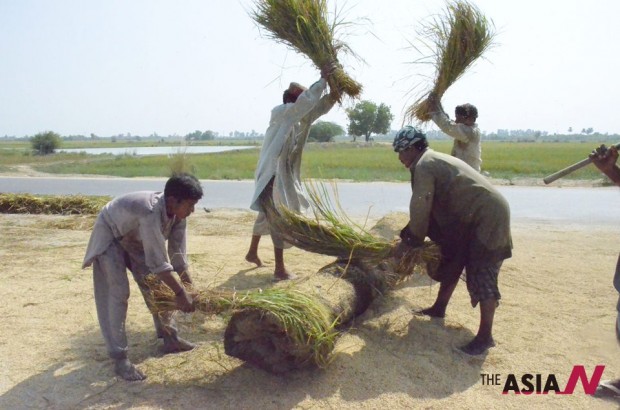Pakistani Farmers Harvest Rice Amid Fear Of Drastic Crop Reduction Due To Heavy Monsoon Rains
Need becomes ‘Mother of Invention’
The delayed but unprecedented heavy monsoon rains had played havoc in Sindh and Balochistan provinces of Pakistan in mid of September 2012. Several deaths, destruction of houses and damage to crops were reported from two provinces.
The overall losses to growers are estimated to be around ninety percent however approximately 50 percent of Sindh’s paddy crop was damaged due to the monsoon rains that continued for five consecutive days breaking the 100-year record, as 550mm rain was measured in that brief period.
The northern parts of Sindh are known for rice cultivation. Northern five districts- Jacobabad, Larkana, Shikarpur, Kashmore-Kandhkot and Kambar-Shahdadkot produce around 70 percent paddy in Sindh over an area of two million acres. The rice cultivation needs much water but with a certain schedule. Despite the fact that rice earns foreign exchange besides meeting needs of country, it had been a practice of Sindh government to impose ban on rice cultivation in command area of River Indus due to water shortage. Owing to acute water shortage, the revenue and police officials are authorized to destroy the rice crops cultivated in violation of ban.
Before the rains, the rice growers were complaining water shortage, but when the nature lashed water-short areas with heavy rains, they started crying and praying ‘Oh God! It’s too much, stop rains and save our crops from destruction and families from starvation.’
The rains stopped but the water is stagnant at low lying paddy growing areas even after over a month. The growers are waiting drying up of stagnant rainwater but the process is very slow being the saline lands.
The photographs show the inundated paddy crop, and a grower’s family busy harvesting, drying and thrashing the paddy plants artificially to get rice for meeting their own food requirements. The poor peasants have no machinery to harvest or thrash the paddy. The female members of a family in Ghotki district are using an empty drum for thrashing the paddy plants while the male peasants are seen thrashing the paddy plants with a trunk of date tree in Larkana district.












































































